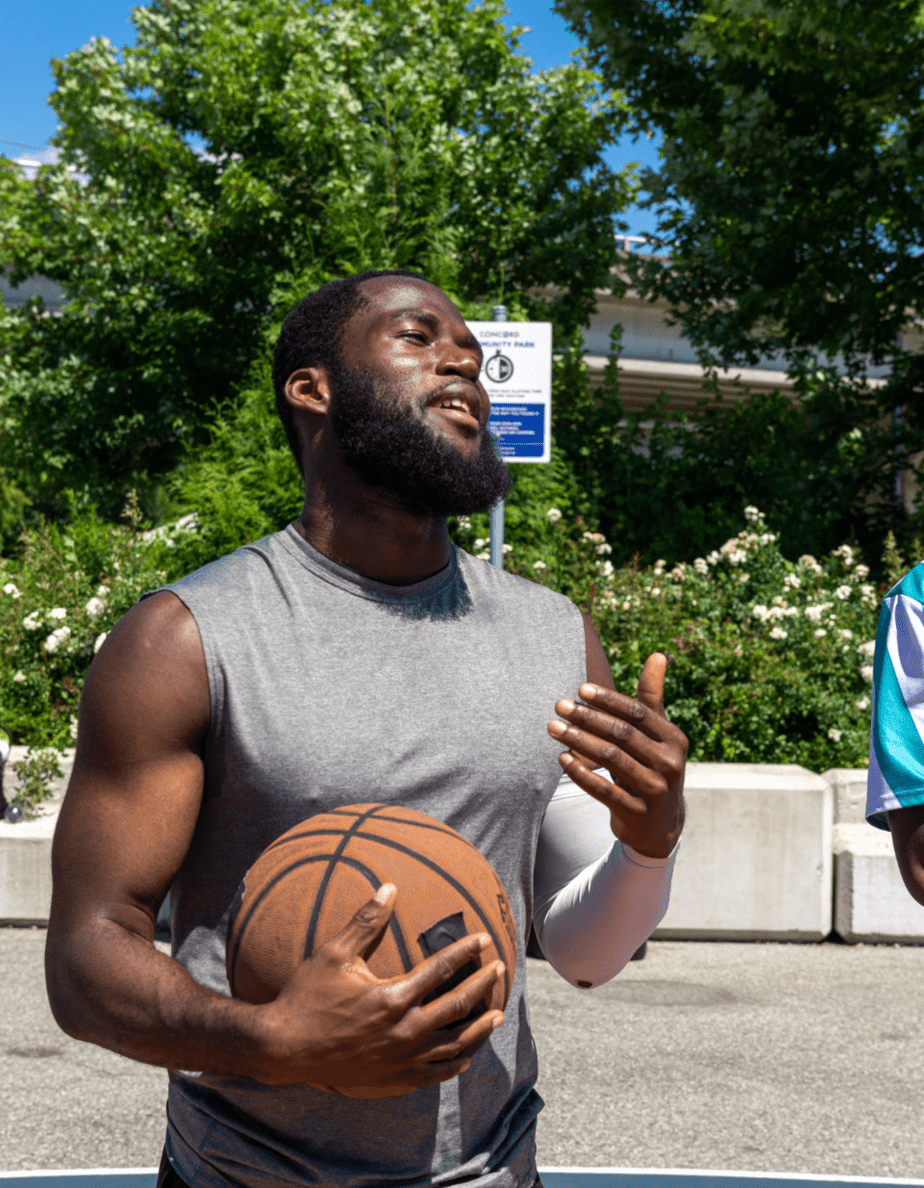Volleyball Strength Training For Beginners
My daughter is about to turn 13 and she was struggling with her overhand serve. The chief problem, noted by several coaches, was that she needed to get stronger. That sent me on a mission of learning as much as I could about volleyball strength training. One coach showed us a few things using some resistance bands and I found this article, written by Marie Zidek, head volleyball coach at DePaul University and a certified strength and conditioning specialist, helpful as starting point to create a volleyball-specific workout plan. I then widdled that list of exercises down to only those that were least complicated for a beginner and someone who has not used weights before. Of course, compliance is always the most important and I wanted strength training exercises she would actually do on her own.
Volleyball Weight Room Workouts
Here are the exercises that we are using for my daughter. I am first concentrating on getting the base movements correct and then we will add weight as she gets more advanced. I want my daughter to be able to use this page for her workouts and have embedded video examples for each exercise.
1. Good Mornings
Good Mornings are a fantastic exercise that targets key muscles used in volleyball. Using two dumbbells, this routine significantly improves your glute and hamstring strength. By strengthening these muscle groups, you also enhance your vertical jump – an essential skill in volleyball for spiking the ball or blocking an opponent’s attack. Clicking the image below will take you to Marie Zidek’s video. I couldn’t find one good enough to embed directly on this page.
Recommended Reps: 3 sets of 10 reps

2. Dumbbell Snatch
A perfect exercise for volleyball players, the Dumbbell Snatch focuses on training triple extension and power development, which are crucial for improving explosiveness. It’s this explosive power that gives you the added advantage during jump serves or spikes.
Recommended Reps: 3 sets of 8 reps
3. Dumbbell Pullover
Similar to the side-to-side twist with the overhead press, the Dumbbell Pullover enhances core and upper body strength. It aids in transferring strength from your core to the upper body rhythmically, which can significantly benefit all overhead volleyball movements, including serving, blocking, setting, and attacking.
Recommended Reps: 3 sets of 12 reps
4. Dumbbell Squat to Press
This is a generalized exercise that caters to all volleyball positions. The Dumbbell Squat to Press not only helps build lower-body strength but also accounts for the upper-body movements crucial to volleyball. This exercise involves setting, serving, attacking, blocking, and transferring power from your lower body to the upper body in a fluid motion.
Recommended Reps: 3 sets of 16-20 reps
5. Biceps with Overhead Press
Primarily aimed at preventing shoulder injuries, the Biceps with Overhead Press exercise is beneficial for attackers. It assists in developing muscles that act as secondary movers during spiking, thereby enabling you to hit the ball with more force and precision.
Recommended Reps: 3 sets of 8 reps
Volleyball Weight Lifting Program Sample
We are going to start with only one set per exercise, but the following table can serve as a good general sample of a volleyball workout routine that can be modified for your use.
| Exercise | Sets | Reps |
|---|---|---|
| Good Mornings | 3 | 10 |
| Dumbbell Snatch | 3 | 8 |
| Dumbbell Pullover | 3 | 12 |
| Dumbbell Squat to Press | 3 | 16-20 |
| Biceps with Overhead Press | 3 | 8 |
This workout plan is a versatile schedule you can implement into your weekly routine. It targets the essential muscle groups involved in volleyball while also ensuring a balance between lower and upper body exercises. Remember to always maintain proper form during each exercise to maximize effectiveness and minimize the risk of injury.

Volleyball Training Resistance Bands
Volleyball training resistance bands are versatile and portable tools that can be used in strength training as an alternative to dumbbells. They offer variable resistance, meaning the resistance increases as the band is stretched, providing a unique way to target muscles and mimic movements used in volleyball. Here’s how they can be integrated into your workout routine for each of the exercises:
1. Good Mornings
The band can be placed under the feet and held at shoulder level with both hands. Perform the good morning exercise as you would with a barbell or dumbbell, by hinging at the hips and maintaining a neutral spine.
2. Dumbbell Snatch
For the snatch, step on the resistance band with one foot. Hold the other end of the band in the opposite hand. Mimic the snatch movement by pulling the band up quickly, extending your hips and knees fully, and raising your arm until it is fully extended above your head.
3. Dumbbell Pullover
Lying on your back with your knees bent and feet flat on the ground, anchor the resistance band under your feet. Grasp the other end of the band with both hands and perform the pullover movement by pulling your arms over your head and then returning them to your thighs.
4. Dumbbell Squat to Press
Stand on the resistance band with feet hip-width apart, holding the band at shoulder height with palms facing each other. Perform a squat and then stand up, pressing the band overhead. This not only targets your lower body but also involves the upper body, making it an excellent full-body exercise.
5. Biceps with Overhead Press
Step on the resistance band with one or both feet and hold the other end in your hands with your palms facing forward. Perform a bicep curl, then press your hands overhead, working both your biceps and shoulders.
In all exercises, ensure the band is securely under your foot or anchored to prevent it from snapping back. Always perform the movements in a controlled manner to prevent injury. Resistance bands are excellent for maintaining resistance throughout the entire movement and can be used for a variety of exercises beyond those listed here. They are a great addition to any volleyball strength training program.
Final Thoughts On Volleyball Strength Training
Incorporating these exercises into my daughter’s regular routine, we hope, will her performance on the volleyball court. I want to make sure this is something she can learn to do consistently. The aim is to do these every 3rd day. We are going to go slow. The last thing I want to do is get her injured or completely dread this routine. My hope is that, when she starts seeing a little increase in strength, the payoff will incentivize continuing the exercise.
Q: Why is strength training important for volleyball players?
A: Strength training is important for volleyball players as it helps improve power, speed, agility, and overall performance. It also aids in injury prevention and enhances muscle endurance, allowing players to perform at their best for longer periods.
Q: Can I use resistance bands instead of dumbbells for strength training?
A: Yes, resistance bands are a versatile and effective alternative to dumbbells. They provide variable resistance and can be used to target the same muscle groups in similar ways as dumbbells. They’re also great for travel or home workouts.
Q: How often should I do strength training exercises for volleyball?
A: Ideally, you should engage in strength training exercises for volleyball 2-3 times per week, ensuring that you have rest days in between for your muscles to recover and grow.
Q: Do these exercises require any special equipment?
A: These exercises can be performed with common gym equipment like dumbbells or resistance bands. Always make sure to use equipment that is suitable for your fitness level to prevent injury.
Q: Can these exercises help with my vertical jump?
A: Absolutely. Exercises like Good Mornings and Dumbbell Snatches are particularly beneficial for enhancing your vertical jump as they strengthen key muscles used in jumping.
Troy Wallace
Troy Wallace is Certified Basketball Speed Specialist and shares his experiences in trying to stay as healthy as possible to stay on the court. He is active in coaching youth basketball in YMCA, Team Work Sports Nebraska, and, currently, in the Jr. Warriors program in Omaha, NE. Visit Troy's Full Author Bio Page or email him directly.
Meaningful conversations happening daily about training, recovery, and injury-specific rehabilitation as well as sport-specific discussions on playing, coaching and refereeing your favorite sport. We welcome experts and those with curious minds seeking answers.
Join The Stay On The Court Community!